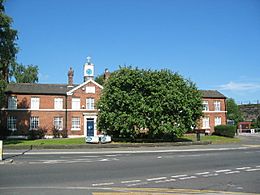Weaver Hall Museum and Workhouse facts for kids
Quick facts for kids Weaver Hall Museum and Workhouse |
|
|---|---|
 |
|
| Location | 162 London Road, Northwich, Cheshire, England |
| OS grid reference | SJ 658 731 |
| Built | 1839 |
| Architect | George Latham |
|
Listed Building – Grade II
|
|
| Designated | 8 July 1969 |
| Reference no. | 1161095 |
| Lua error in Module:Location_map at line 420: attempt to index field 'wikibase' (a nil value). | |
The Weaver Hall Museum and Workhouse is a fascinating place in Northwich, Cheshire, England. It tells the story of how people lived and worked in West Cheshire throughout history. The museum used to be called the Salt Museum because it focused on the history of salt extraction. This was a very important local industry that started way back in Roman times.
In 2010, the museum changed its name to Weaver Hall Museum and Workhouse. This was because it started to cover more of the area's history. It also tells the story of the building itself, which used to be a workhouse. The museum building was built in 1839 and is located on the A533 road. It is a special historic building, listed as Grade II in the National Heritage List for England.
Contents
Discover History at Weaver Hall Museum
Weaver Hall Museum has a huge collection of items. These items show the history of Cheshire, from ancient times to today. You can learn about old buildings, how people lived, and the industries that shaped the area.
Some of the permanent displays include a Victorian workhouse schoolroom. Here, you can imagine what it was like for children to learn in the past. There's also the Board of Guardians boardroom, where important decisions were made.
The museum also has a large collection of over 8,000 images. These pictures show the history of west Cheshire, especially the salt and chemical industries. They also show how canal transport was used to move goods.
Besides its regular displays, the museum often has special events. These include visiting art exhibitions, holiday activities, and interesting talks. It even has its own mini-cinema, called the Regalette. This cinema is named after the last cinema in Northwich, which closed in 2007. In 2009, more than 20,000 people visited Weaver Hall.
The Story of Weaver Hall Museum
How the Museum Started
The idea for a salt museum began in the 1800s. Two local salt business owners, Thomas Ward and John Brunner, thought Northwich needed a place to explain why it was known as the "salt capital of the world." They gave a library and museum to the town in 1887.
The first museum collection shared a building with the Northwich library. However, the building collapsed because of mine subsidence. This was a big problem in the town where salt was mined underground. A new building for both the library and museum was built in 1909. This building is still there today, but it only houses the Northwich library.
Moving to the Workhouse Building
The museum collection moved to its current home at Weaver Hall in June 1981. This move happened thanks to the hard work of Mary, Lady Rochester. She played a big part in setting up the museum in its new location. When it first opened there, it was called The Salt Museum. It showed exhibits that focused on the history of the salt industry and its effects on the area.
In 2004, Matt Wheeler became the Curator. He started many special exhibitions and events, which made more people visit the museum. One famous exhibition in 2009 was called 'Above the Clouds: Mallory & Irvine and the Quest for Everest'. It featured items from famous explorers, George Mallory and Andrew ('Sandy') Irvine. They were both from Cheshire and tried to climb Mount Everest. This exhibition was one of the most complete ever done on Mallory and Irvine.
In 2010, another museum was planned nearby at the former Lion Salt Works. This led to changes at the Salt Museum, and it became the Weaver Hall Museum and Workhouse. Its focus also grew to include the wider history of the west Cheshire area.
The History of the Museum Building
The building that is now Weaver Hall was opened in 1839. It was built because of a new law called the Poor Law Amendment Act 1834. This law changed how help was given to poor people across England and Wales. Groups of local areas were combined into "unions." These unions were in charge of helping the poor and needy.
The law said that able-bodied people who needed help had to live in a workhouse. The conditions in workhouses were often strict. This was meant to encourage people to find jobs instead of relying on charity.
The Northwich Union Workhouse was planned in 1837. It was designed by an architect named George Latham. In 1850, a hospital for people with fevers was added. In 1863, better "receiving wards" with proper baths were put in.
The workhouse system ended in April 1930. The Northwich Workhouse then became a public assistance institution run by Cheshire County Council. In 1948, the building became the Weaver Hall Old People’s Home. Most of the workhouse buildings were taken down in the 1960s. However, the original front part of the building and a special room called the Board of Guardians room (built in 1892) remained. The main building stopped being an old people's home in 1968.
See also
- Salt in Cheshire
- Open pan salt making
- Weaver Hall, Darnhall


